western table manner西餐礼仪
- 格式:ppt
- 大小:7.04 MB
- 文档页数:40
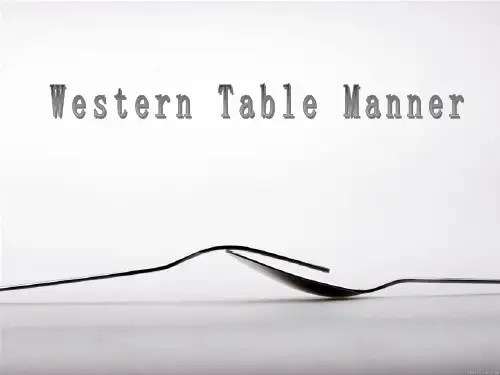
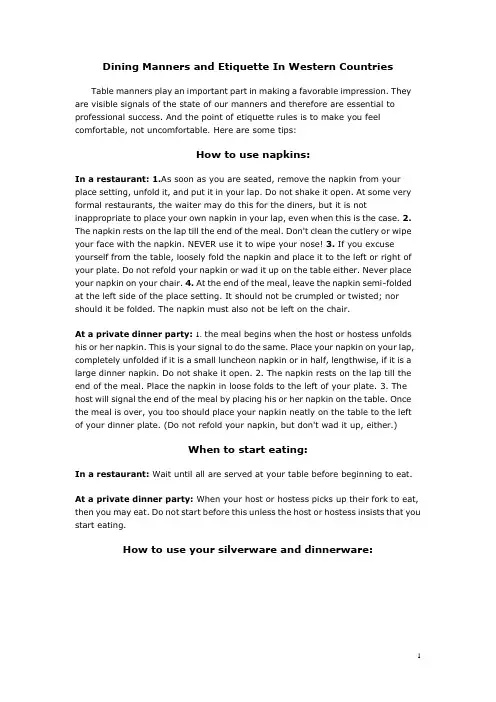
Dining Manners and Etiquette In Western CountriesTable manners play an important part in making a favorable impression. They are visible signals of the state of our manners and therefore are essential to professional success. And the point of etiquette rules is to make you feel comfortable, not uncomfortable. Here are some tips:How to use napkins:In a restaurant:1.As soon as you are seated, remove the napkin from your place setting, unfold it, and put it in your lap. Do not shake it open. At some very formal restaurants, the waiter may do this for the diners, but it is not inappropriate to place your own napkin in your lap, even when this is the case. 2. The napkin rests on the lap till the end of the meal. Don't clean the cutlery or wipe your face with the napkin. NEVER use it to wipe your nose! 3. If you excuse yourself from the table, loosely fold the napkin and place it to the left or right of your plate. Do not refold your napkin or wad it up on the table either. Never place your napkin on your chair. 4. At the end of the meal, leave the napkin semi-folded at the left side of the place setting. It should not be crumpled or twisted; nor should it be folded. The napkin must also not be left on the chair.At a private dinner party: 1. the meal begins when the host or hostess unfolds his or her napkin. This is your signal to do the same. Place your napkin on your lap, completely unfolded if it is a small luncheon napkin or in half, lengthwise, if it is a large dinner napkin. Do not shake it open. 2. The napkin rests on the lap till the end of the meal. Place the napkin in loose folds to the left of your plate. 3. The host will signal the end of the meal by placing his or her napkin on the table. Once the meal is over, you too should place your napkin neatly on the table to the left of your dinner plate. (Do not refold your napkin, but don't wad it up, either.)When to start eating:In a restaurant: Wait until all are served at your table before beginning to eat.At a private dinner party: When your host or hostess picks up their fork to eat, then you may eat. Do not start before this unless the host or hostess insists that you start eating.How to use your silverware and dinnerware:Use thesilverwarefarthestfrom yourplate first.Here's theSilverwareanddinnerware rule:Eat to yourleft, drink toyour right. Any food dish to the left is yours, and any glass to the right is yours. Starting with the knife, fork, or spoon that is farthest from your plate, work your way in, using one utensil for each course. The salad fork is on your outermost left, followed by your dinner fork. Your soup spoon is on your outermost right, followed by your beverage spoon, salad knife and dinner knife. Your dessert spoon and fork are above your plate or brought out with dessert. If you remember the rule to work from the outside in, you'll be fine.Use one of two methods when using the fork and knife:American Style: Knife in right hand, fork in left hand holding food. After a few bite-sized pieces of food are cut, place knife on edge of plate with blades facing in. Eat food by switching fork to right hand (unless you are left handed). A left hand, arm or elbow on the table is bad manners.Continental/European Style: Knife in right hand, fork in left hand. Eat food with fork still in left hand. The difference is that you don't switch hands-you eat with your fork in your left hand, with the prongs curving downward. Both utensils are kept in your hands with the tines pointed down throughout the entire eating process. If you take a drink, you do not just put your knife down, you put both utensils down into the resting position: cross the fork over the knife. Once used, your utensils, including the handles, must not touch the table again. Always rest forks, knives, and spoons on the side of your plate or in the bowl. For more formal dinners, from course to course, your tableware will be taken away and replaced as needed. To signal that your are done with the course, rest your fork, tines up, and knife blade in, with the handles resting at five o'clock an tips pointing to ten o'clock on your plate. Any unused silverware is simply left on the table.General social and dining etiquette rules:•Arrive at least 10 minutes early unless otherwise specified.•Pass food from the left to the right.•Always say please when asking for something. Be sure to say thank you to your server and bus boy after they have removed any used items.•If asked for the salt or pepper, pass both together, even if a table mate asks for only one of them. This is so dinner guests won't have to search fororphaned shakers.•Set any passed item, whether it's the salt and pepper shakers, a bread basket, or a butter plate, directly on the table instead of passinghand-to-hand.•Never intercept a pass. Snagging a roll out of the breadbasket or taking a shake of salt when it is en route to someone else is a no-no.•Food is served from the left. Dishes are removed from the right. •Butter, spreads, or dips should be transferred from the serving dish to your plate before spreading or eating.•Never turn a wine glass upside down to decline wine. It is more polite to let the wine be poured and not draw attention. Otherwise, hold your hand over the wine glass to signal that you don't want any wine.•Always scoop food away from you.•Taste your food before seasoning it.•Do try a little of everything on your plate.•Don't blow on your food to cool it off. If it is too hot to eat, take the hint and wait.•Keep elbows off the table. Keep your left hand in your lap unless you are using it.•Do not talk with your mouth full. Chew with your mouth closed.•Cut only enough food for the next mouthful. Eat in small bites and slowly. •Don't clean up spills with your own napkin and don't touch items that have dropped on the floor. You can use your napkin to protect yourself from spills.Then, simply and politely ask your server to clean up and to bring you a replacement for the soiled napkin or dirty utensil.•Do not blow your nose at the dinner table. Excuse yourself to visit the restroom. Wash your hands before returning to the dining room. If you cough, cover your mouth with your napkin to stop the spread of germs and muffle the noise. If your cough becomes unmanageable, excuse yourself to visit the restroom. Wash your hands before returning to the dining room. •Turn off your cell phone or switch it to silent or vibrate mode before sitting down to eat, and leave it in your pocket or purse. It is impolite to answer a phone during dinner. If you must make or take a call, excuse yourself from the table and step outside of the restaurant.•Do not use a toothpick or apply makeup at the table.•Whenever a woman leaves the table or returns to sit, all men seated with her should stand up.•Do not push your dishes away from you or stack them for the waiter when you are finished. Leave plates and glasses where they are.Dividing or sharing the restaurant bill with others:•Always assume that if you’re dining in a group of more than 6 people (3 couples), that the check is going to be divided evenly among everyone.•When dining when other couples, If you know you’re going to ask for a separate check, tell the server before you order so that the process issimplified later.•Take into account any significant ($15 or more) price differences in orders. If someone only orders soup and everyone else orders 2-3 courses, it’s not fair to make them pay the same.•If there are a couple people not drinking alcohol while the rest of the group is, separate the beverage total to take this into account and don’tovercharge the non-drinkers.Proper tipping etiquette in a restaurant:At a restaurant, always leave a tip. Tips can vary from 15% to 25%.Waiter: 15% to 20% of the bill; 25% for extraordinary serviceWine steward: 15% of wine billBartender: 10% – 15% of bar billCoat check: $1.00 per coatCar attendant: $1.00 - $2.00Remember that the amount you tip reflects the total price before any coupons, gift certificates, etc. Just because you get a discount, does not mean that your server did not serve up the full order. If the owner of the restaurant serves you himself, you should still tip him. He will divide the tip among those who work in the kitchen and dining room.。

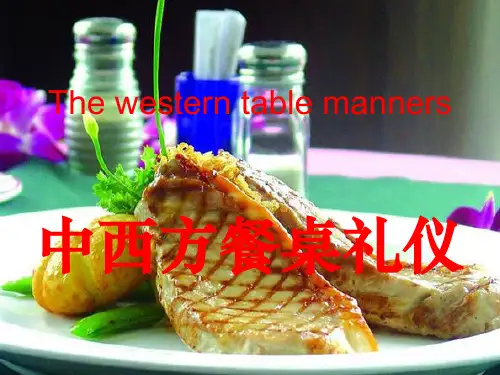
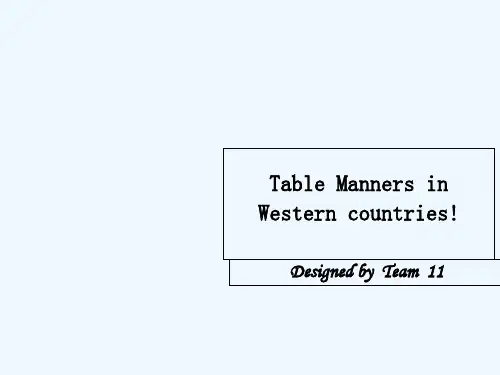
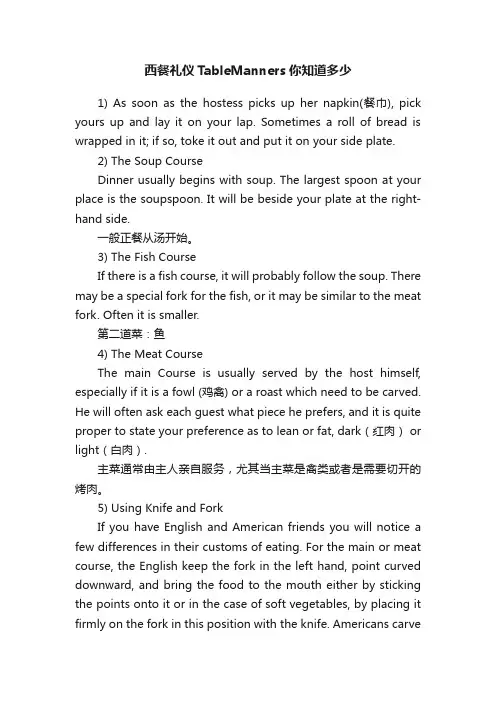
西餐礼仪TableManners你知道多少1) As soon as the hostess picks up her napkin(餐巾), pick yours up and lay it on your lap. Sometimes a roll of bread is wrapped in it; if so, toke it out and put it on your side plate.2) The Soup CourseDinner usually begins with soup. The largest spoon at your place is the soupspoon. It will be beside your plate at the right-hand side.一般正餐从汤开始。
3) The Fish CourseIf there is a fish course, it will probably follow the soup. There may be a special fork for the fish, or it may be similar to the meat fork. Often it is smaller.第二道菜:鱼4) The Meat CourseThe main Course is usually served by the host himself, especially if it is a fowl (鸡禽) or a roast which need to be carved. He will often ask each guest what piece he prefers, and it is quite proper to state your preference as to lean or fat, dark(红肉) or light(白肉).主菜通常由主人亲自服务,尤其当主菜是禽类或者是需要切开的烤肉。
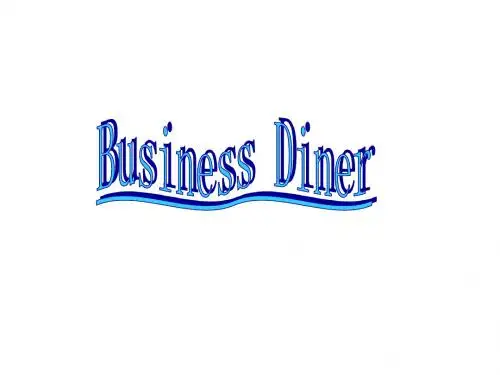
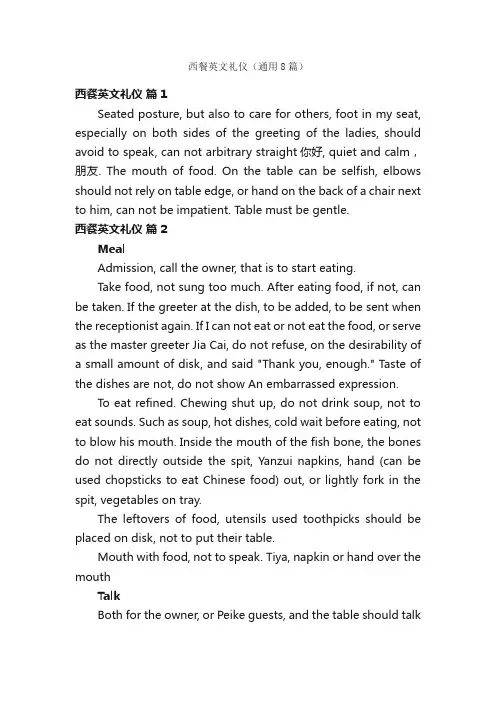
西餐英文礼仪(通用8篇)西餐英文礼仪篇1Seated posture, but also to care for others, foot in my seat, especially on both sides of the greeting of the ladies, should avoid to speak, can not arbitrary straight你好, quiet and calm,朋友. The mouth of food. On the table can be selfish, elbows should not rely on table edge, or hand on the back of a chair next to him, can not be impatient. Table must be gentle.西餐英文礼仪篇2MealAdmission, call the owner, that is to start eating.Take food, not sung too much. After eating food, if not, can be taken. If the greeter at the dish, to be added, to be sent when the receptionist again. If I can not eat or not eat the food, or serve as the master greeter Jia Cai, do not refuse, on the desirability of a small amount of disk, and said "Thank you, enough." Taste of the dishes are not, do not show An embarrassed expression.To eat refined. Chewing shut up, do not drink soup, not to eat sounds. Such as soup, hot dishes, cold wait before eating, not to blow his mouth. Inside the mouth of the fish bone, the bones do not directly outside the spit, Yanzui napkins, hand (can be used chopsticks to eat Chinese food) out, or lightly fork in the spit, vegetables on tray.The leftovers of food, utensils used toothpicks should be placed on disk, not to put their table.Mouth with food, not to speak. Tiya, napkin or hand over the mouthTalkBoth for the owner, or Peike guests, and the table should talkto people, especially around next to him. Not only with a few acquaintances or two of the same words. If the neighbor did not know, introduce myself first.ToastAs the guest of honor at the banquet to participate in foreign, should be used to understand each other's toast, that is why people toast, when the toast, and so on, in order to make the necessary preparations. Clink, and the owner of the guest of honor first touch, many people may indicate a toast at the same time, not necessarily clink. Toast careful not to cross when the clink. And the master chief guest at the speech, toast, the meal should be suspended, to stop talking and pay attention to listen, and do not like to take this opportunity to smoke. Stood when the national anthem is played. The master and guest of honor, then finished with VIP guests clink staff, often to T eachers sprinkle the other table, should an emergency occur, rose to toast. Clink, to pay tribute to each other by sight.Dinner toast each other, said the friendly, lively atmosphere, but bear in mind that excessive drinking. Drinks too easily slip of the tongue, and even loss, it is necessary to control himself in less than one-third of those who have.UndressIn social occasions, no matter how hot the weather can not solve the buttons off his clothes in public. Small informal dinner, and invited guests, such as the masters of undress, gentlemen can take off his jacket in the back.Tea(Or coffee) tea, coffee, plus get milk, sugar, cup self to join with small mixing teaspoon, teaspoon back into the still small dishes, usually milk, sugar are in full bloom with separate utensils.Drink at the right hand is holding the Cup, the left hand side small dishes.FruitChili, Apple, do not bite with a whole should be cut into four with a fruit knife, 6, and then peeled with a knife, nuclear, and then eat with their hands, peeling knife-edge when North Korea, cut inside from the outside . First banana peel, cut into small pieces to eat with a knife. With a knife and cut into pieces to eat oranges, orange, lychee, longan and so on can eat Bole Pi. The rest, such as watermelon, pineapple, etc., usually go into skin yuan, can be used when eating a fruit knife and cut into small pieces with fork food.Shui YuIn the banquet, the chicken, lobster, fruit, in some cases sent a small Shui Yu (Tongpen, crystal bowls or Boli Gang), a floating rose petal water or lemon slices for the use of hand-washing (some people have mistaken for beverages, As a result become a joke). Wash hands when they take turns damp fingers gently Shuanxi, and then use a small napkin or towel dry.Memorial itemsSome of the master for each person attending or have a small souvenir of flowers. At the end of the banquet, call the owner to bring guests. In such, it can be said that it commended the 12 small gifts, but do not have to solemnly said. In some cases, foreign visitors, the dinner menu is often taken as a souvenir, and sometimes I please with those who signed the menu as a souvenir. In addition to the special master to indicate things as souvenirs, a variety of entertainment products, including candy, fruit, cigarettes and so on, are not taken away.ThanksSometimes in the private sector attended the banquet activities, often my business card or memo said.Will buffet, cocktail buffet vegetables take, cocktail reception, greeter serve, not to get a gun, I have to be sent to the front of the airport project. Did not get around the first time, not to rush to get their second. Do not dish around the table next to the check End Tuikai that, in order to let other people get.The use of tablewareChinese food is the major bowls, chopsticks, is the Western knives, forks, plates. Dinner is usually a foreigner to eat Chinese food, Chinese food is also for the West to eat more, before we go, knife and fork set. The knife and fork is the use of his right hand with a knife, hold the left hand fork, cut into small pieces of food, and then sent a cross inside the mouth. Europeans do not use changing hands, from cutting food were sent to hold the left hand fork. Americans, after cutting, put down the knife, fork right hand holding the entrance to send food. When dinner knife and fork in accordance with the order from outside access inside. After each course, emissions will be set within feet close together and knife and fork to eat that. If finished, then put into a character or a cross placed, knife-edge to inside. Chicken, lobster, indicated by the master, can be torn by hand to eat, or can be cut meat knife and fork, cut into small pieces to eat. Cut with bone or hard shell of meat, meat fork must fork in prison, knife-edge close to cross under the cut, so as not to slide open. Vegetable, be careful not to hit too much force plate and sound. Is not easy to cross the food, or food is not easy on the fork, gently push it available Dao fork. In addition to the soup, do not have to spoon feeding. With deep soup plate or small bowl full bloom, when to drink with a spoon scoop from the inside out into the mouth, is aboutto do drink, can be set to hold out a little. Eat with the smell of food, such as fish, shrimp, game, etc. equipped with a lemon, juice will hand out food in the drip, to smell out.Are involved in an accident caseBanquet in progress, due to carelessness, the occurrence of unusual circumstances, such as too much force, knife and fork so that the impact plate, audible, or drop utensils on the floor, or knock over drinks and so on, should not have to worry calm. Tableware out of touch sound, a small sitting next to (or host) say "I am sorry." Tableware can be dropped to send a greeter to pay. Spilling drinks spilled next to him who should apologize to help dry; as the other women, as long as the clean handkerchief or napkin and handed to her own dry.(1) 餐巾Napkin(2) 魚叉Fish Fork(3) 主菜叉Dinner or Main Course Fork(4) 沙拉叉Salad Fork(5) 汤杯及汤底盘Soup Bowl & Plate(6) 主菜盘Dinner Plate(7) 主菜刀Dinner Knife(8) 鱼刀Fish Knife(9) 汤匙Soup Spoon(10) 面包及奶油盘Bread & Butter Plate(11) 奶油刀Butter Knife(12) 点心匙及点心叉Dessert Spoon and Cake Fork(13) 水杯Sterling Water Goblet(14) 红酒杯Red Wine Goblet(15) 白酒杯White Wine Gobl西餐英文礼仪篇3十条应该遵守的西方礼仪How to behave at table in western society?1.When helping a woman pull her chair to the table, hold it and guide it. Don't shove it against the back of her legs.1. 为女士拉椅子的时候,要把椅子抓住了,留个角度,让女士好走过去。


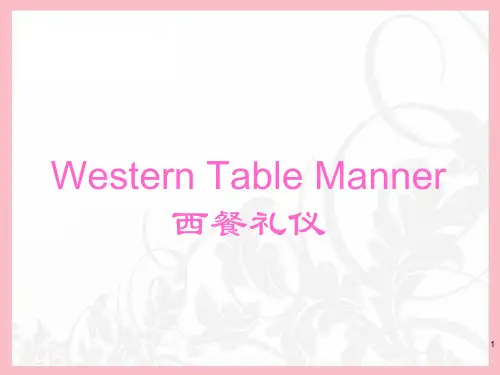
Meeting and Greeting People In Public PlacesIntroduction Special OccasionsInvitation With Strangers and FriendsIn the Home Personal Habits and AppearanceTable Manners Some Points for MenIn School 西⽅礼仪 Some Common Manners in the WestIt is a great help for the person who is learning a foreign language to know some customs and manners for the people who speaks it, because the language is very closely associated with them. I will tell you some common western manners.1. Meeting and Greeting People1) GreetingThe simplest thing to say is "Good morning," "Good afternoon'" or "good evening." This greeting is given to one whom you know only slightly, or to any one you are passing quickly. "How are you" is usually used when you are not in such a hurry. No answer is expected other than " Fine, thank you." "hello' is the commonest form of greeting between good friends.2) When a Man Raises His HatIf you are wearing a hat which can be taken bold of easily, it is customary to raise it slightly off your head when you greet a girl or a woman.3) When to Shake HandsIt is customary to shake hands when you first meet someone. And usually friends shake hands when they meet after not having seen each other for some time. However it is not necessary to shake hands.4) Use the person's NameIt is always good form to use the name of the person you are greeting. You might say, "Good Morning, Mr. Moncrieff" or " Hello, Franklin.," A person's surname should be used unless he is good friend or school-mate.2. Introduction1) How to Introduce PeopleIn introducing two people, the general rule is: Introduce other people to the person you wish to honor. The old are honored in the West as in China. Women have been honoured in the West since the days of knighthood(骑⼠时代).2) Rising at IntroductionA man always rise for an introduction, except that it is sometimes all right for an elderly man to remain seated when a young man is introduced to him. The hostess always rises for an introduction.3) Introducing YourselfIf you want to meet someone, it is better to ask a friend who know him to introduce you. But sometimes at a meeting or gathering it is all right to introduce yourself to a fellow-student, or to one of the same sex and position.3. Invitation1) You Must Reply to an InvitationForeign custom is much more strict than Chinese custom in the matter of replying to invitations. When you receive an invitation you should answer it immediately, saying definitely whether you are able to accept it or not.2) Written or Verbal ReplyIf the invitation is given by word of mouth, in conversation or at a chance meeting, you should answer at once whether you can come or not. If you cannot give an answer at that time, you may say, "May I let you know this evening?" Or some suchwords.4. In the Home1) The Right Time to ArriveWhen invited to luncheon, dinner, or supper, it is very impolite to arrive late, as it is usually planned to have the meal at the exact hour given in the invitation.2) In arrivalWhen you arrive, the hostess or some member of the family will probably meet you at the door and take your coat and hat. In the winter time you should dress more lightly than usually, as you may expect the rooms to be warmer than in most Chinese homes.3) In a few minutes the hostess will ask her guests to come in to dinner. She may or may not ask each gentleman to take a lady in. If she does, the lady will take the gentleman's arm as they walk into the dinning room. If she does not, the ladies will go in first, followed by the gentlemen. The hostess will either point out their seats to the guests as they come in or have a place card at each place with the guests name on it.4) How Long to StayAfter the meal is over it is not polite to leave for at least half an hour, lest you seem to have come only for the meal. An evening dinner invitation usually implies that you stay for the whole evening. The hostess often plans some after-dinner entertainment.5) What to Say on LeavingWhen leaving any kind of a party, a guest always expresses his appreciation to the hostess. Some such words as these are appropriate. "Thank you so much. I've had a delight evening."5. Table Manners1) As soon as the hostess picks up her napkin(餐⼱), pick yours up and lay it on your lap. Sometimes a roll of bread is wrapped in it; if so, toke it our and put it on your side plate.2) The Soup CourseDinner usually begins with soup. The largest spoon at your place is the soup spoon. It will be beside your plate at the right-hand side.3) The Fish CourseIf there is a fish course, it will probably follow the soup. There may be a special fork for the fish, or it may be similar to the meat fork. Often it is smaller.4) The Meat CourseThe main Course is usually served by the host himself, especially if it is a fowl(鸡禽) or a roast which need to be carved. He will often ask each guest what piece he prefers, and it is quite proper to state your preference as to lean or fat, dark(红⾁)or light(⽩⾁).5) Using Knife and ForkIf you have English and American friends you will notice a few differences in their customs of eating. For the main or meat curse, the English keep the fork in the left hand, point curved downward, and bring the food to the mouth either by sticking the points onto it or in the case of soft vegetables, by placing it firmly on the fork in this position with the knife. Americans carve the meat in the same position, then lay down the knife and taking the fork in the right hand with the point turned up, push it under a small piece of food without the help of the knife and bring it to the moth right-side-up.6) Helping Yourself and RefusingIf a servant passes food around, he will pass the dish in at your left hand so that you can conveniently serve yourself with your right hand. Never serve yourself while the dish is on your right; it is then the turn of your neighbor on the right. It is polite to take some of everything that is passed to you. But if there is something you may not like, you may quietly say: "No thank you."7) Second HelpingsThe hostess may or may not ask if you would like a second helping, according to the formality of the meal. If she does and you accept it, you should pass your plate to her or to the servant with the knife and fork still lying on it.8) The Salad CourseA salad is eaten with a fork only held in the right hand with points turned up. There is usually a special one for the salad, a little smaller than the meat fork.9) Bread and ButterBread is taken in the fingers and laid on the side plate or the edge of the large plate, it is never take with a fork. Butter is taken from the butter dish with the butter knife and placed on the side plate, not on one's bread.10) Other Things on the TableWhen there are things on the middle of the table, such as bread, butter, jelly, pickles, nits, candies, you should not take any until the hostess ahs suggested that they be passed.11) Leaving the TableIt is impolite for a guest to leave the table during a meal, or before the hostess gives the signal at the end. When the hostess indicates that the dinner is over, she will stat to rise from her seat and all the guests she rise from theirs at the same time. 12) Various rules and SuggestionsSit up straight on your chair; Do not put much food in your mouth at a time; Drink only when there is no food in your mouth; Try not to get into your mouth anything that will have to be taken out; Do not make any nose when you eat; Do not clean your teeth at the table or anywhere in public, either with your finger or a tooth pick(⽛签), not even with you tongue.6. In School1)Greeting the TeacherIf you are in a very large class, it may not be necessary to greet the teacher on arriving, but it is always quite proper if you happen to catch the teacher's eye as you enter.2) Coming LateIt is bad manners to come late to class. If you are unavoidably late an apology should be made to the teacher either at the time or after class.3) Talking in ClassIt if bad manners in the schoolroom, as elsewhere, to talk while anyone else is taking.7. In Public Places1) Traffic LawsThe coming of the motor car made definite traffic law and regulations a practical necessity. To obey these law is not so mucha matter of curtsey(礼貌) as a moral obligation(义务).2) For People WalkingPeople walking should keep to the sidewalks and should keep to the right of the sidewalk.3) The TheaterThe theater proper is more formal than the movies. At the theater best clothes are in order; evening clothes are often worn. 4) The MoviesThe movies are more informal. Any kind of respectable clothes may be worn, and small confection(糖果) may be eaten quietly as long as there are no objectionable noses to annoy one's neighbors.5) In ChurchIt is usual for anyone attending church to take some money along for the offering, as it is a regular part of every church service and is used for the work of the church. Good clothes, but never evening clothes, are worn to a church service.8. Special Occasions1) BirthdayBirthday in the West, as in China, are considered occasions for congratulations and sometimes for gifts from near friends. 2)The WeddingIf one receives an announcement of a wedding after it is over, a note of congratulation may be sent, but a gift is not necessary.3) The FuneralFunerals, of course, are always sand, but the tendency in Western countries is against making any show of one's feelings at the funeral. The idea behind this is that the person dead would wish this last meeting of his friends in his honor and remembrance to be full of tender, happy recollections of his life.9. With Strangers and Friends1) Lending and borrowing are more matters of principle in the West than in the East. Things borrowed in the West are definitely expected to be returned, whether it is fifty dollars or merely a friend's pencil.2) Don't Be CuriousIt is impolite to be curious about the private affairs of others, such as age, salary, religion and marriage.3) Thanks for GiftsWhen some one gives you a present, it is very impolite to neglect thank him for it.4) One Hand OnlyIn china we use two hands when giving something to a person, or when receiving it, if we want to be very polite. In the West this would seem awkward and impolite.10. Personal Habits and Appearance1) People judge you at first by what they see, so particular attention should be paid to your personal appearance.2) Using a HandkerchiefAlways carry a clean handkerchief. Do not use it while it is folded, and do not fold it after you use it.3)SpittingIn the West it is considered very impolite to spit, even upon the street.4) SmokingSmoking is very prevalent(普遍), both by men and by women. If you are a guest in a home where no others are smoking, it is better to refrain(忍住) from smoking, you may say, "Would you mind if I smoked?".11. Some Points for Men1) With a LadyAlways allow the lady to precede you in places where one has to go before the other except in the following case: when getting off a street car, train, bus, or out of an automobile; when going up stair; when opening a heavy door. When you are walking along the street with a lady, always walk on the outside.2) At a DanceIf you wish to dance with a certain lady, go to her, bow, and say:" May I have the pleasure of a dance?"Selected from Western Manners by Earl and Katharine Willmontt and translated by Wan Rongfang西⽅礼仪为什么打招呼? 在欧美国家见⾯打招呼是很⾃然的,即使是不认识。